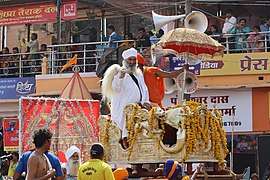Nirmala (sect)

Nirmala (Punjabi: ਨਿਰਮਲੇ) is an Indian religious sect of ascetics, interpret the Sikh philosophy in Vedantic terms. They variously claim to have originated during the period of Guru Nanak (15th-16th century) or Guru Gobind Singh (17th century).
Origin
The origin of the Nirmalas is uncertain: the sect is first mentioned in the Sikh literature towards the end of the 18th century. In the 19th century, some Nirmala scholars traced their origin to the period of the first Sikh Guru, Nanak, but some others traced their origin to the period of the last Sikh Guru, Gobind Singh.[1]
A popular account of the sect's origin appears in Nirmal Panth Pardipika (1891) by the Nirmala scholar Giani Gian Singh:[2] In 1686, Guru Gobind Singh met a Sanskrit scholar named Pandit Raghunath, and asked him to open a Sanskrit school for Sikhs. However, Raghunath refused to do so, because the Sikhs included people of low-caste origin. Therefore, the Guru sent five Sikhs (Bir Singh, Ganda Singh, Karam Singh, Ram Singh and Saina Singh[1]) to Varanasi to learn Sanskrit. These Sikhs were first members of the group that later came to be known as the Nirmala sect.[3] After mastering Sanskrit in Kashi, they returned to Anandpur, where they were honoured by the title Nirmala (Sanskrit for "pure" or "unsullied").[4] They then taught and translated the texts they learned into Punjabi.[5] They also then took the Amrit initiation into the Khalsa panth.[6]
The historicity of this account is doubtful, as there are very few mentions of Nirmalas before the 19th century.[2][7] Pashaura Singh and Louis E. Fenech hypothesize that the Nirmalas originated much later or are descended from the Udasis, who are similar to them in ascetic lifestyle, celibacy and Vedantic interpretation of Sikh philosophy.[8]
History

Patronage from Sikh nobles, especially the rulers of the Phulkian states, helped the Nirmalas become a prominent religious order.[8] Sardar Dhyan Singh of Shahbad willed his estate to Karam Singh Nirmala. In 1766, Sadda Singh of Bahirwala offered seven villages to Bhagat Singh Nirmala, although the latter declined the offer. Sardar Jai Singh's daughter-in-law granted two villages to the Nirmal dera at Kankhal.[9]
Sardar Ganda Singh of Bhangi Misl offered 13 villages to Jai Singh Nirmala. In 1796, Maharaja Ranjit Singh also granted a sanad for land to Nihal Singh Nirmala. On both occasions, the Nirmalas passed on the properties to the Udasi akhara of Santokh Das.[9]
Philosophy and practices
Like the Udasis, the Nirmalas interpret the teachings of the Sikh Gurus in context of Vedanta.[8] They view the first Sikh Guru, Nanak, as an Advaita Vedantist, a follower of Shankara, and a defender of the Sanatana dharma.[10]
However, compared to the Udasis, the Nirmalas have shared a closer relationship the mainstream Khalsa Sikhs. Many prominent Nirmala sants preached mainstream Sikhism in Punjab, and Nirmala akharas have played an important role in training Sikhs. But after the Akali movement, the Khalsa attempts to create a Sikh identity completely distinct from Hindus made the Khalsa-Nirmala relationship fragile.[8]
Locations
The Nirmala Panchaati akhara at Kankhal, established with grants from the rulers of Phulkian states, has the highest status among all Nirmala chapters.[8] Other major Nirmala centres are located at Haridwar, Allahabad, Ujjain, Trimbak, Kurukshetra and Patna.
Notable Nirmalas
- Kavi Santokh Singh, (1787 - 1843), writer of historical Suraj Parkash
- Gaini Gyan Singh, (1822-1921), Perhaps most prominent Nirmale
- Pundit Tara Singh (1822–1891), Punjabi and Sanskrit scholar
- Kahn Singh Nabha, (1861 – 1938), Prominent Sikh Scholar
- Balbir Singh Seechewal, Prominent environmentalist
References
- 1 2 Sulakhan Singh (2001). "Heterodoxy in Sikhism: An Exposition of Some Sectarian Developments". In Parm Bakhshish Singh. Punjab History Conference, Thirty-second Session, March 17-19, 2000: Proceedings. Punjabi University. p. 78. ISBN 978-81-7380-722-0.
- 1 2 Sulakhan Singh (2005). "Nirmal Panth Pardipika". In Sukhadial Singh. Punjab History Conference, Thirty-seventh Session, March 18-20, 2005: Proceedings. Punjabi University. pp. 220–221. ISBN 978-81-7380-990-3.
As the Nirmalas do not seem to have been adequately mentioned in the Sikh literature before the 19th century, it is difficult to uphold the contention of Giani Gian Singh as historically true, rather it seems highly inprobable.
- ↑ Madanjit Kaur (2007). Guru Gobind Singh: Historical and Ideological Perspective. Unistar. p. 198. ISBN 978-81-89899-55-4.
- ↑ Bhagat Lakshman Singh (1995). Short Sketch of the Life and Works of Guru Gobind Singh. Asian Educational Services. p. 67. ISBN 9788120605763.
- ↑ Seetal, Sohan. Prophet of Man, Guru Gobind Singh. Lyall Book Depot. p. 195.
- ↑ Kaur, Madanjit (2007). Guru Gobind Singh: Historical and Ideological Perspective. Chandigarh: Unistar Books. p. 198.
- ↑ W. H. McLeod (2009). The A to Z of Sikhism. Scarecrow Press. pp. 148–149. ISBN 978-0-8108-6344-6.
- 1 2 3 4 5 Pashaura Singh; Louis E. Fenech (2014). The Oxford Handbook of Sikh Studies. OUP Oxford. pp. 377–378. ISBN 978-0-19-100412-4.
- 1 2 Surjit Singh Gandhi (2007). History of Sikh Gurus Retold: 1606-1708 C.E. Atlantic. pp. 971–974. ISBN 9788126908585.
- ↑ Lynn Teskey Denton (2004). Female Ascetics in Hinduism. SUNY Press. pp. 179–. ISBN 978-0-7914-6179-2.